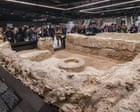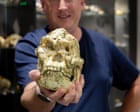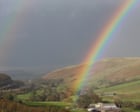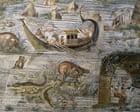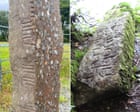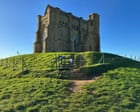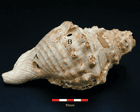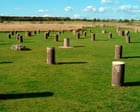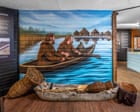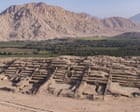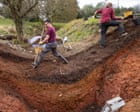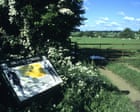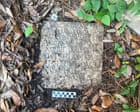Top news stories from the world of archaeology.
- Warmers and Shelley to get through winter | Brief lettersby Guardian Staff on 2025-12-17
Raynaud’s syndrome | What follows winter | Beaver bones | Honda Jazz | Maga | LagerYour article on how to cope with winter (17 December) left one point out. Raynaud’s syndrome causes sufferers to lose blood circulation in their hands in cold weather. The best help I have found for it is buying a couple of HotRox – little metal eggs that can be charged up to release heat and restore blood supply. Bring on the snowballs!Clare PassinghamOxford• Re your 10 ways to thrive as the temperature drops, Shelley nailed it in one sentence: “If Winter comes, can Spring be far behind?”Jacqueline NobleDorchester, Dorset Continue reading…
- Beachy Head Woman may be ‘local girl from Eastbourne’, say scientistsby Hannah Devlin Science corespondent on 2025-12-17
Exclusive: DNA advances show Roman-era skeleton, once hailed as first black Briton, came from southern EnglandBeachy Head Woman, a Roman-era skeleton once hailed as the earliest known black Briton and who scientists later speculated could be of Cypriot descent, has now been shown to have originated from southern England.The mystery of the skeleton’s shifting identity was finally resolved after advances in DNA sequencing produced a high-quality genetic readout from the remains. Continue reading…
- Relief and reward for passengers as Rome’s ‘museum stations’ finally openby Angela Giuffrida in Rome on 2025-12-16
Archaeological treasures revealed during construction at two metro stops led to years of delaysMetro passengers in Rome can now peruse ancient history while in transit after the opening of two long-awaited stations showcasing a vast trove of treasures unearthed during their construction – including the remnants of a military barracks built during the reign of the emperor Trajan and 28 wells, along with the votives offered up in thanks.The Colosseo-Fori Imperiali, a sprawling station beside the Colosseum descending across four levels, and Porta Metronia, in the area of San Giovanni, form part of the driverless Metro C, an underground line that connects the suburbs of Rome to the centre. Continue reading…
- Little Foot hominin fossil may be new species of human ancestorby Donna Lu on 2025-12-14
Australian researchers think the skeleton found in South Africa is not the same species as two found in the same South Africa cave system Little Foot, one of the world’s most complete hominin fossils, may be a new species of human ancestor, according to research that raises questions about our evolutionary past.Publicly unveiled in 2017, Little Foot is the most complete Australopithecus skeleton ever found. The foot bones that lend the fossil its name were first discovered in South Africa 1994, leading to a painstaking excavation over 20 years in the Sterkfontein cave system. Continue reading…
- Country diary: An unlikely job for a farmer – preserving a roman fort | Andrea Meanwellby Andrea Meanwell on 2025-12-10
Tebay, Cumbria: We have 30 acres of Roman remains underground here, but thanks to recent storms and a redirected river, I fear they’re not safeToday I am out in freezing temperatures photographing a riverbank. Mist, which we call “clag”, swirls over the higher ground and I cannot see any of our livestock that are overwintering on the hills.The reason I’ve turned photographer may come as a surprise: on Low Borrowbridge farm we have a Roman fort and civilian settlement dating to the first and second century AD, including what is thought to be a Roman parade ground and cemetery. The remains are extensive, covering at least 12 hectares (30 acres) under the ground. Since Victorian times, there have been successive excavations, most recently in 2011-12 when a mansio (a guesthouse for people visiting the fort) was found. A geophysical survey has also located the headquarters building and the commander’s house. Continue reading…
- Ancient Egyptian pleasure boat found by archaeologists off Alexandria coastby Dalya Alberge on 2025-12-08
First-century luxury vessel matches description by the Greek historian Strabo, who visited city around 29-25BC An ancient Egyptian pleasure boat that matches a description by the first-century Greek historian Strabo has been discovered off the coast of Alexandria, to the excitement of archaeologists.With its palaces, temples and the 130 metre-high Pharos lighthouse – one of the seven wonders of the ancient world – Alexandria had been one of the most magnificent cities in antiquity. The pleasure boat, which dates from the first half of the first century AD, was 35 metres long and constructed to hold a central pavilion with a luxuriously decorated cabin. Continue reading…
- Linguists start compiling first ever complete dictionary of ancient Celticby Steven Morris on 2025-12-08
More than 1,000 words used as far back as 325BC to be collected for insight into past linguistic landscapeIt is not likely to be a hefty volume because the vast majority of the material has been lost in the mists of time. But the remnants of a language spoken in parts of the UK and Ireland 2,000 years ago are being collected for what is being billed as the first complete dictionary of ancient Celtic.The dictionary will not be huge because relatively few words survive, but experts from Aberystwyth University say they expect they will end up with more than 1,000 words. Continue reading…
- Water leak in the Louvre damages hundreds of works, museum saysby Agence France-Presse in Paris on 2025-12-07
Open valve in heating system affects 300 to 400 items just weeks after a brazen jewel theft raised security concernsA water leak in late November damaged several hundred works in the Louvre’s Egyptian department, the Paris museum said on Sunday, weeks after a brazen jewel theft raised concerns over its infrastructure.“Between 300 and 400 works” were affected by the leak discovered on 26 November, the museum’s deputy administrator, Francis Steinbock, said, describing them as “Egyptology journals” and “scientific documentation” used by researchers. Continue reading…
- Country Diary: A lonely chapel that whispers and roars | Sara Hudstonby Sara Hudston on 2025-12-04
Abbotsbury, Dorset: Long ago this was the place to come and wish for a husband. It is empty today, but still so full of presenceTwo ascending buzzards dazzle against the sun as I climb to St Catherine’s Chapel alone on its hill above the sea. It is the saint’s own feast day (25 November), when women once came to recite a charm for getting married. The traditional wording was blunt: “A husband, St Catherine, a handsome one, St Catherine, a rich one, St Catherine, a nice one, St Catherine, and soon, St Catherine.” Impatient supplicants added in dialect: “arn‑a‑one’s better than narn-a-one” (anyone’s better than no one).Today, I am the only person there. The lichened walls of golden sandstone are pitted and worn by gales and salt, the east window so eroded that it has been boarded over for renovation. Inside it is quite bare, long ago stripped of its medieval stained glass and fittings, nothing but pale stone and sunlight printing shadows on the walls. Continue reading…
- Norman conquest coin hoard to go on show in Bath before permanent displayby Steven Morris on 2025-12-03
Trust announces major grant to exhibit £4m Chew Valley Hoard, which was found by metal detectorists in 2019 The coins were buried in a valley in the English West Country almost 1,000 years ago at a time of huge political and social turmoil.A millennium on, plans have been announced to bring the Chew Valley Hoard, 2,584 silver coins hidden shortly after the Norman conquest, back to the south-west of England. Continue reading…
- Shells found in Spain could be among oldest known musical instrumentsby Sam Jones in Madrid on 2025-12-02
Conch-shell trumpets discovered in Neolithic settlements and mines in Catalonia make tone similar to french horn, says lead researcherAs a child, Miquel López García was fascinated by the conch shell, kept in the bathroom, that his father’s family in the southern Spanish region of Almería had blown to warn their fellow villagers of rising rivers and approaching flood waters.The hours he spent getting that “characteristically potent sound out of it” paid off last year when the archaeologist, musicologist and professional trumpet player pressed his lips to eight conch-shell trumpets. Their tones, he says, could carry insights into the lives of the people who lived in north-east Spain 6,000 years ago. Continue reading…
- Archaeologists say they have proof humans carved huge pits near Stonehengeby Steven Morris on 2025-11-27
Research team uses range of novel methods and equipment to analyse ‘extraordinary’ Durrington pit circleThe presence of an extraordinary circle of yawning pits created by Neolithic people near Stonehenge has been proved thanks to a novel combination of scientific techniques, a team of archaeologists is claiming.The architects of Stonehenge may have had the heavens in mind when they built the great stone monument in Wiltshire, but the team believes the makers of the Durrington pit circle were more interested in an underworld. Continue reading…
- DNA reveals stone age teenager as chewer of 10,500-year-old ‘gum’by Nadeem Badshah on 2025-11-23
The prehistoric birch tar found in Estonia contained traces of saliva that were analysed by genetics expertsA piece of stone age “gum” chewed by a teenage girl 10,500 years ago has been discovered by archaeologists in Estonia.The Institute of History and Archaeology at the University of Tartu discovered the prehistoric birch tar had impressions of teeth marks and traces of saliva. Continue reading…
- Rosemary Church obituaryby Stephen Church on 2025-11-23
My mother, Rosemary Church, who has died aged 86, was a primary school teacher and a local historian whose work focused on Faringdon in Oxfordshire, the town where she lived for much of her life.In 1978 she founded the Faringdon and District Archaeological and Historical Society, whose members catalogued gravestones in churches, transcribed documents of local interest, collected photographs from a bygone age, put on exhibitions and talks, and set up a history resource centre for use by the community. On occasion they also did field work, going in ahead of construction teams and excavators to see what they could uncover before anything was built over. Continue reading…
- Rare bronze and iron age log boats reveal details of Cambridgeshire prehistoryby Harriet Sherwood on 2025-11-14
Well-preserved oak and maple boats used for transport and fishing to be displayed in PeterboroughAfter lying undisturbed in mud for more than 3,000 years, three rare bronze and iron age log boats have emerged to offer fresh insights into prehistoric life.The boats were among nine discovered in a Cambridgeshire quarry 13 years ago – the largest group of prehistoric boats found in the same UK site. Most were well preserved, with one still able to float despite its long incarceration. Continue reading…
- Archaeologists discover how oldest American civilisation survived a climate catastropheby Dan Collyns in Vichama on 2025-11-05
Experts find artefacts left behind in Caral showing how population survived drought without resorting to violenceArchaeologists in Peru have found new evidence showing how the oldest known civilization in the Americas adapted and survived a climate catastrophe without resorting to violence.A team led by the renowned Peruvian archaeologist Ruth Shady, 78, concluded that about 4,200 years ago, severe drought forced the population to leave the ancient city of Caral, and resettle nearby. Continue reading…
- ‘It would be wonderful’: the team hoping to unearth ‘Cornwall’s Stonehenge’by Steven Morris on 2025-10-12
Experts and volunteers working at Castilly Henge have been trying determine if it is the county’s lost great stone circleIt was a grey Cornish autumn day, but Henry Stevens’s tough shift digging in a field next to the A30 was about to get very exciting.Her eye was caught by something glinting in the soil and she picked up a flake of flint that had lain for thousands of years within what might just turn out to be a Cornish version of Stonehenge. Continue reading…
- Why it’s worth taking a wider look at biarchal cultures | Lettersby Guardian Staff on 2025-10-10
In places such as Canada, the US, parts of Africa, southern India and Polynesia, biarchal traditions are almost within living memory, says Simon DawsonLaura Spinney offers a compelling glimpse into the possibility that gender-egalitarian societies once flourished in the past – cultures where women held substantial autonomy and influence (The big idea: Was prehistory a feminist paradise?, 5 October). However, her article remains constrained by a predominantly Eurocentric lens.Most of Spinney’s examples are drawn from Europe and Asia, where patriarchal systems displaced “biarchal” models (those based on shared gender governance) in the distant past. Yet in some regions biarchal cultures endured far longer. In places such as Canada, the US, parts of Africa, southern India and Polynesia, these biarchal traditions are almost within living memory. Continue reading…
- A battlefield hit by HS2 – and planning rules | Letterby Guardian Staff on 2025-10-07
Permitted development regulations allowed the contractor to strip topsoil and damage potential archaeology, writes Simon MarshIt isn’t just the countryside and its residents that are suffering due to HS2 (‘It’s been beyond difficult’: earthworks of HS2 take toll on Chilterns residents, 2 October). The high-speed rail contractor has recently done considerable damage to potential archaeology on the nationally important registered battlefield at Edgcote, a Wars of the Roses battle fought in 1469.HS2 stripped 30cm of soil from an area equivalent to around 16 football pitches to allow storage of hundreds of thousands of tons of earth dug out along the route of the new railway. The archaeology of battle sits in the topsoil and understanding its distribution is key. HS2’s contractor undertook a geophysical survey prior to work beginning. But this method is not designed to find the types of small artefacts typically found on a medieval battlefield. If it had used a systematic metal-detecting survey instead, such material would not have been lost. Continue reading…
- New Orleans couple discovers ancient Roman grave marker in their yardby Ramon Antonio Vargas on 2025-10-07
Discovery of 1,900-year-old headstone dedicated to Roman sailor sets off effort to repatriate item to ItalyA New Orleans couple clearing away undergrowth in their home’s yard unearthed a grave marker, setting off a quest for answers about how the roughly 1,900-year-old relic ended up there – and an effort to repatriate it to Italy.The remarkable discovery was the work of Tulane University anthropologist Daniella Santoro and her husband, Aaron Lorenz, according to a report published online Monday by the magazine of New Orleans’s Preservation Resource Center (PRC). Continue reading…


